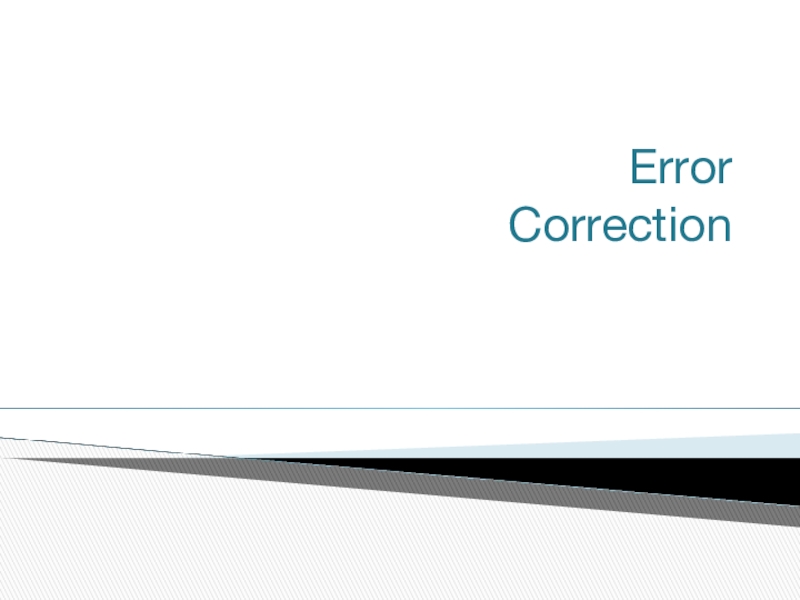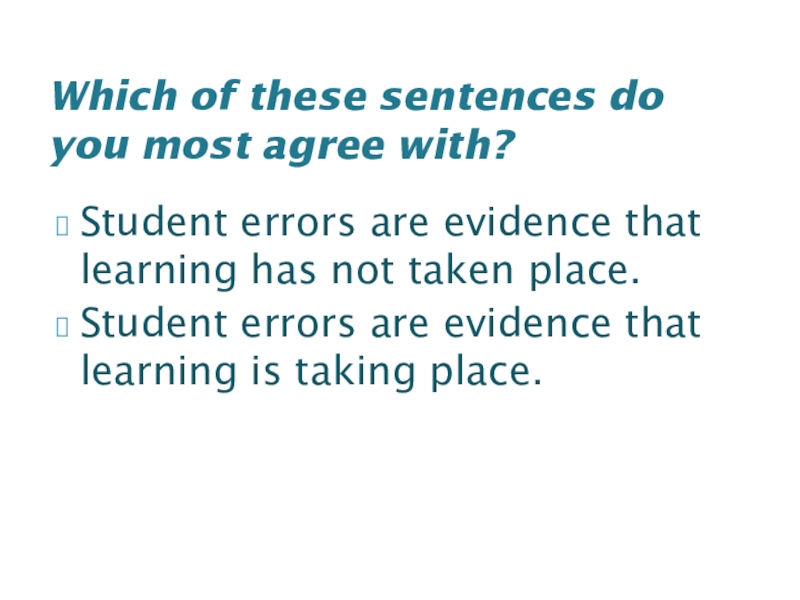- Главная
- Разное
- Образование
- Спорт
- Естествознание
- Природоведение
- Религиоведение
- Французский язык
- Черчение
- Английский язык
- Астрономия
- Алгебра
- Биология
- География
- Геометрия
- Детские презентации
- Информатика
- История
- Литература
- Математика
- Музыка
- МХК
- Немецкий язык
- ОБЖ
- Обществознание
- Окружающий мир
- Педагогика
- Русский язык
- Технология
- Физика
- Философия
- Химия
- Шаблоны, фоны, картинки для презентаций
- Экология
- Экономика
Презентация, доклад к семинару Error Correction
Содержание
- 1. Презентация к семинару Error Correction
- 2. What is the role of error in
- 3. Student errors are evidence that learning has
- 4. Gaps in knowledgeInterference (i.e. from L1)Developmental errorsForgettingHigh
- 5. Aims when correcting:To help students become more
- 6. A student makes an errorDecide what kind
- 7. What kind of error?ErrorsLexicalGrammaticalDiscourseSocioculturalPhonological
- 8. First decide if it is useful to correct the errorthenCorrect now or laterWhen to correct?
- 9. Who will correct?
- 10. Indicating/correcting errorsTell the students (eg There’s an
- 11. For an upcoming lessonPlan an error correction
What is the role of error in language learning?What decisions do teachers need to make regarding error correction?What techniques can teachers use to correct student errors?Overview
Слайд 2
What is the role of error in language learning?
What decisions do
teachers need to make regarding error correction?
What techniques can teachers use to correct student errors?
What techniques can teachers use to correct student errors?
Overview
Слайд 3Student errors are evidence that learning has not taken place.
Student errors
are evidence that learning is taking place.
Which of these sentences do you most agree with?
Слайд 4Gaps in knowledge
Interference (i.e. from L1)
Developmental errors
Forgetting
High demands (responding under time
pressure)
Experimenting with language
Taking risks
Experimenting with language
Taking risks
Why do learners make errors?
Слайд 5Aims when correcting:
To help students become more accurate in their language
usage
To build learner confidence
To raise learner awareness
To acknowledge achievement & progress
To meet student/parent expectations
To build learner confidence
To raise learner awareness
To acknowledge achievement & progress
To meet student/parent expectations
Why correct students?
Слайд 6A student makes an error
Decide what kind of error has been
made
Decide whether to deal with it
Decide when to deal with it
Decide who will correct
Decide on an appropriate technique
Decide whether to deal with it
Decide when to deal with it
Decide who will correct
Decide on an appropriate technique
Teacher Decisions
Слайд 10Indicating/correcting errors
Tell the students (eg There’s an error in that sentence)
Facial
expressions
Gestures
Finger correction (hold on to the ‘error’ finger – eg the third word)
Repeat sentences up to the error (eg They looked for a…?
Echo (with a change of intonation or stress)
Ask a question (eg Was this last week?)
Draw a timeline on the board
Write the problem sentence on the board (for discussion)
Use the phonemic chart (to point at incorrect phoneme)
Gestures
Finger correction (hold on to the ‘error’ finger – eg the third word)
Repeat sentences up to the error (eg They looked for a…?
Echo (with a change of intonation or stress)
Ask a question (eg Was this last week?)
Draw a timeline on the board
Write the problem sentence on the board (for discussion)
Use the phonemic chart (to point at incorrect phoneme)
How to correct?
Слайд 11For an upcoming lesson
Plan an error correction strategy for each stage
of the lesson, and indicate this in the lesson plan
Submit the lesson plan for a brief discussion of why you chose these techniques prior to the lesson
Submit the lesson plan for a brief discussion of why you chose these techniques prior to the lesson
Follow Up Task
















